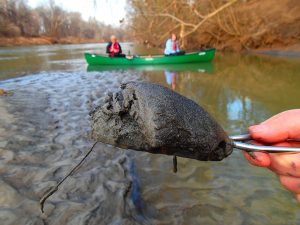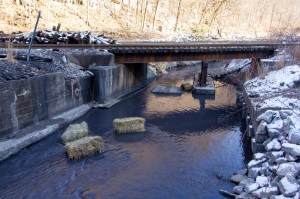Toxic Warnings: Recent Spills Underscore Lack of Water Oversight
By Kimber Ray
In the early morning hours of Jan. 9, Kim Thompson was getting ready to leave her South Charleston home in Kanawha Co. — the most populated region in the mountains of West Virginia — and head out to her job as field supervisor for a local telecommunications company. As she twisted the shower faucets off, she had no way to imagine that those final drips of water signaled the last time she would use that shower.

Coal ash from the Dan River; in the month of the spill, the ash pooled up in eddies along the bank near the site of the leaking pipe in Eden, N.C. Photo by Brian Williams, courtesy Dan River Basin Association
Many people affected by Freedom Industry’s toxic chemical leak into the Elk River — a spill that contaminated the drinking water of more than 300,000 West Virginia residents — still do not feel safe using their water. “That day marked a complete change in how we live,” reflects Thompson.
As reports of the disaster swept across the nation, it began to emerge that much of this news was nothing new. Not only has chronic water pollution long been widespread in West Virginia, but the lurking possibility of serious contamination spills over into every state.
In North Carolina and Virginia, this overflowed into reality on Feb. 2 at Duke Energy’s retired coal plant near Eden N.C. A 50-year-old stormwater pipe precariously situated beneath an unlined coal ash pond burst, allowing 39,000 tons of ash to enter the Dan River. The incident would be classified as the third largest coal ash spill in national history.
The next week, a Patriot Coal plant spilled more than 100,000 gallons of coal slurry into Fields Creek, W.Va. Six miles of water were blackened with a thick mixture of toxic heavy metals and chemicals; the riverbank was plastered with a gray sludge. Although West Virginia Department of Environmental Protection Secretary Randy Huffman called the spill “significant,” he didn’t consider it significant enough to warrant much beyond an order to stop.

Efforts to contain the Fields Creek coal slurry spill with hay bales and gravel proved to be unsuccessful. Photo by Foo Conner
Following these three spills, publications and television programs including National Geographic, the Washington Post and The Rachel Maddow Show began questioning: “How did these spills happen?” and “How safe is our water?” The U.S. Attorney General’s Office launched criminal investigations of state officials and company executives in both states.
The widening scope of public scrutiny has only dug up deeper concerns. In both West Virginia and North Carolina, mounting evidence suggests that state officials have weakened state and federal environmental rules — despite the known risks — and citizens are paying the price. Regulations on many dangerous chemicals are nonexistent, state officials are known to turn a blind eye to poorly maintained facilities and, even when people are left with poisoned water and a fouled environment, violators are rarely held accountable. All too often, the public has been expected to pick up the tab for the hidden costs of coal — whether it’s waste from mining, or waste from burning coal for electricity.
Such discoveries are unsurprising to Dr. Avner Vengosh, a professor of geochemistry and water quality at Duke University. Although major spills receive the most attention, chronic pollution poses a greater threat to communities because the poison is more subtle.
“You don’t need to wait for a spill to realize there’s a problem. And it’s not just North Carolina — it’s a national issue,” says Vengosh. “Without any monitoring, we don’t even know what’s happening. We should be working to prevent things before they happen rather than dealing with them after they happen.”
In the Wake of the Impact: Dan River
“We still haven’t heard from Duke on their plans for the cleanup,” says Jenny Edwards, program director for the environmental group Dan River Basin Association. “Can they clean it up? What’s the impact of the clean up? We’re concerned about the long-term health of the river.”
Coal ash — the waste produced by burning coal for electricity — contains a lineup of toxic health offenders including arsenic, selenium, mercury and lead. Since the leaking pipe was plugged Feb. 8, the water in the river now runs clear and the slicks of coal ash on the riverbank that Edwards saw spattered with wildlife tracks have washed away. The real damage sits below the surface. In layers sometimes five feet thick, coal ash blankets the bottom of the river for more than 70 miles.

Coal ash from the Dan River power plant is seen along the banks in the month of the spill. Photo by Brian Williams, courtesy Dan River Basin Association
“The coal ash is so fine and sticky that it covers and coats everything it touches,” explains Dr. Dennis Lemly, a research biologist with the U.S. Forest Service and an associate professor at Wake Forest University. “One of the first things to be affected are the animals that can’t leave, mussels and clams, benthic insects, crayfish, all those little critters that can’t swim away or get away from it are just covered up and suffocated,” he adds.
At the beginning of March, the Dan River Basin Association was already reporting an abnormal number of dead mussels and clams piling up on the riverbank. Lemly is concerned things will only get worse. For more than 30 years, he has investigated selenium, a chemical in coal ash that causes death and deformity in fish. Selenium poisoning can persist for generations, accumulating as creatures eat one another and even passing along in fish from parent to offspring.
A persistently poisoned fish population could have a sweeping impact on river life. “There’s a chain effect, that’s why it’s called a food chain,” Lemly says, “and if you cut the bottom length of the food chain then everything above it suffers.” For now, it’s too soon to tell just how powerful this chain effect will be; the answer awaits the arrival of migrating fish this coming spring.

River life affected by the Dan River coal ash spill includes mollusks, pictured here, dead, as well as turtles and two endangered species. Photo by Brian Williams, courtesy Dan River Basin Association
About 20 miles downstream from the site of the spill, the Dan River flows through the heart of the city of Danville, Va. Joe King, city manager, can even see the river from his window at work. “People are very intimate with the river here,” he comments. “It’s not in a gorge, it’s in the city.” King watched the river turn a murky gray in the days after the spill, but after the first week, visible signs of coal ash were gone.
Danville is an old industrial city where tobacco and textile manufacturing once thrived. In an effort to build a new economy, the city has been working on repurposing old warehouses to serve as businesses and apartments. King is concerned that the spill may create a falsely negative perception of the city, causing residents to leave and businesses to stay away. “That’s the last thing we need,” he adds.
Testing of tap water in the city has consistently shown that the contaminants are being filtered out. In fact, the heavy metals of coal ash are easy to remove from drinking water because the particles are so large. Yet some residents are skeptical; bottled water sales in the area have increased since the spill.
One root of this doubt may be the unusual way that Duke Energy and the North Carolina Department of Environment and Natural Resources initially handled the spill. Duke first alerted the city of the incident by calling the Danville fire department to say there may have been a coal ash spill and offering no details. Public notification of the spill was deferred for more than 24 hours. Accurate water quality testing, plugging the leaking pipe and work to clean up the Dan River have all suffered delays as well, leaving the public angry and confused.
In the Wake of the Impact: West Virginia
When West Virginia American Water Company first issued “Do Not Use” advisories to 300,000 water customers across nine counties on Jan. 9, it was a confident order. In the weeks to follow, it morphed into a confusing suggestion.
“It’s your decision,” said Governor Earl Ray Tomblin during a Jan. 20 news conference. “I’m not going to say absolutely, 100 percent that everything is safe. But what I can say is if you do not feel comfortable, don’t use [the water].”
In the hours after the cracked storage tank owned by Freedom Industries spilled a 10,000-gallon chemical blend of crude methylcyclohexane methanol, or MCHM, and propylene glycol phenyl ether, or PPH, into West Virginia’s Elk River, nine counties served by West Virginia American Water were affected. The water company had been alerted of the spill by noon, but believed they could filter out the contaminants. It was 5:45 p.m. before customers were warned to stop using their water.
Health officials with the federal Centers for Disease Control initially announced that levels of MCHM below one part per million were safe for consumption. But two days later the agency added that this level may not be safe for pregnant women, leaving residents to wonder just how officials were getting these numbers. Public confidence was further shaken when The Charleston Gazette reported that this threshold was based on a 1990 study of ten rats and a different chemical — pure MCHM, which is not identical to crude MCHM. There are still no studies on how MCHM affects humans.
The government lifted the “Do Not Use” order ten days after the spill. Yet in the days that followed, hospital admissions for symptoms related to MCHM dramatically increased. Hundreds of residents have been treated at local hospitals for chemical burns, rashes and chemical-induced pneumonia even as West Virginia American Water Company continued to assert that their water was safe.
Then, on Jan. 23, Freedom Industries, which had remained mysteriously silent during the crisis, emerged only to report that a second chemical — PPH — was also in the spill, but the ingredients were a trade secret.
“It makes you suspect when you know how many days passed and then they said ‘Oh, by the way, PPH was in there as well,’” says local resident Kim Thompson, “and as far as I know, they never did testing for PPH.” The lack of trust now makes her wonder what else citizens are not being told.

As security looks on, free water is distributed on March 14 in front of the Governor’s Mansion lawn in Charleston, W.Va. Residents and grassroots organization Mountain Justice coordinated the event as part of ongoing efforts to call for increased support of West Virginians still impacted by the chemical spill. Photo by Joe Solomon
By early February, the CDC said the water was safe for all residents, even pregnant women. But many residents are still demanding bottled water. Even in March, the distinct, licorice-like odor of MCHM continues to permeate many households across West Virginia. A National Science Foundation-funded study confirmed residents’ fears, finding that the human nose is able to detect significantly lower levels of MCHM than even the most advanced analytical tools.
“I’ve been to many homes where people are still scarred on their hands from this water, and who knows the long-term effects?” comments Thompson. “That’s why so many people aren’t using the water, because they were physically affected, lied to and continuously ignored.”
Bulk water distribution centers around the state have been quietly shutting down despite no one — not even health or government officials — being certain that minute levels of chemicals are not continuing to impact the health of residents.
West Virginia Clean Water Hub — a grassroots organization that formed the same day the spill was announced—is one of the few organizations still distributing free water in the state. Thompson joined as a volunteer in the week when the organization began. “This chemical spill made me helpless, angry and useless,” she states, “and by getting involved, that in turn has led me to at least feel a little bit of power, and I’m trying to give that to communities.”
Thompson has since emerged as the Water Hub’s leading point person in Charleston, guiding and maintaining the group’s water distribution in her city. At her own home, bottled water and water from rain catchments and melted snow is used for everything they do. A camp shower in her basement is used for bathing. “I will never probably drink it ever, ever again,” says Thompson, “or cook with it, or wash, or brush my teeth with it, my animals will never drink with it.”
Jennifer Weidhaas, a civil and environmental engineer at West Virginia University who also received a grant from the National Science Foundation, is studying how crude MCHM travels through the water system. She says given the miles and miles of pipes that need to be cleaned out, low concentrations of the chemical may be in the drinking system for some time to come.
Breaching a History of Disregard
The day following the chemical spill, Gov. Tomblin announced, “This is not a coal company incident; this is a chemical company incident.”
“That’s an absolute lie,” says Jack Spadaro, a former mine inspector who has worked on coal issues in West Virginia for decades, “[MCHM] is a chemical used in coal preparation.” In order to clean and process coal for use at coal-fired power plants and smelting furnaces, chemicals such as MCHM are used to remove impurities. This results in a waste byproduct known as coal slurry, which is what blackened six miles of Fields Creek on Feb. 11 when a valve at Patriot Coal malfunctioned.
Spadaro is not surprised by the Patriot Coal spill. “What happened on Fields Creek is commonplace,” he states. “It happens every few weeks.” He says state officials have “a history of accommodating the coal industry” and he can recall a long list of incidents where this came at the expense of West Virginia communities.

Water samples taken at Fields Creek on the day of the spill by Appalachian Voices revealed levels of contaminants in violation of the Clean Water Act, as well as the presence of MCHM. At press time, the West Virginia Department of Environmental Protection had not released test results from the spill or issued any fines. Photo courtesy Appalachian Voices
One such case in Boone County’s Seth-Prenter area casts a striking reflection on the Elk River chemical spill. For the past decade, people had been reporting painful rashes and burns and, throughout the years, locals experienced an unusually high rate of conditions such as kidney and liver failure and brain tumors. Shortly before these symptoms started to appear, Massey Energy — later acquired by Alpha Natural Resources — began pumping 1.9 billion gallons of coal slurry into nearby abandoned mines for permanent storage.
Several studies indicated that the coal slurry had migrated into local well water. But despite the fact that the same chemicals injected deep underground were also found in residents’ taps, WVDEP Secretary Randy Huffman denied that coal slurry was the cause. With about 350 individuals affected, the incident received minimal attention. Residents filed a lawsuit and, in the years before their case was settled in 2012, many relied solely on bottled water. Relief came in the form of a public water line connecting them to West Virginia American Water.
The Elk River chemical spill shattered this temporary respite. Maria Lambert, a resident of Prenter, describes the current smell of her tap water as the same “very sweet, stomach-sickening odor we endured eight years ago,” in a recent Business Insider article. Lambert’s experience is not uncommon — Thompson says many people have been connected to American Water pipes after their wells were contaminated by coal-related activities. Documents from the state’s commission governing public utilities support this, with water company executives reporting on extending service to coal impacted communities.
Still, Thompson adds, “Who would have thought you could have these chemicals just above a water plant and no one was regulating them?”
The Myth of Overregulation
The water crises in West Virginia and North Carolina turned the public eye to a long-standing problem: for much of the hazardous waste connected to coal, regulations and inspections are limited, and enforcement is rare.
As far as state or federal environmental laws are concerned, neither MCHM nor other waste from coal is considered “hazardous.” Because of this, West Virginia and North Carolina do not have strict requirements on how these contaminants are stored, and contamination of nearby drinking and groundwater occurs daily.
“What most people don’t realize is, a lot of stuff is less regulated than household waste,” says Amy Adams, a former employee of the North Carolina Department of Environment and Natural Resources and current North Carolina Campaign Coordinator for Appalachian Voices, the publisher of this newspaper. “Our waterways are protected from trash dumps, but not unlined pits of toxic waste.”
Although the federal Clean Water Act of 1972 sets acceptable limits on water pollutants, states are responsible for enforcement. Many waterways have been in violation of the Clean Water Act for decades, but state regulators seldom act — they may not even notice. In states such as North Carolina and West Virginia, inspections have been curbed, in part due to continued budget cuts to state and federal environmental agencies.
Adams says cuts to DENR became particularly hard-hitting in 2011. “We have to have people with boots on the ground if we are to be vigilant in protecting our resources,” Adams comments. For North Carolina and West Virginia, those “boots on the ground” often belong to the same companies responsible for polluting the waterways. Both states have a self-reporting system where companies are expected to monitor and report their discharges. Sometimes companies disclose their violations, sometimes they don’t — it doesn’t tend to matter either way because enforcement on the state level has become increasingly weak or non-existent.

Duke Energy initially reported that the ruptured Dan River pipe was constructed from concrete. Investigations have revealed that while the visible ends of the pipe are concrete, cheaper, failure-prone metal was used for the length of the pipe. Photo courtesy Appalachian Voices
The day before the West Virginia chemical spill, Gov. Tomblin declared in his state address that he would “never back down from the EPA” even as others were calling for the federal Environmental Protection Agency to step up. Since 2009, widespread criticism of West Virginia’s Department of Environmental Protection has pushed environmental groups in West Virginia to petition the EPA to take over the state agency. Federal regulators are still investigating their complaints.
A bill to regulate above-ground chemical storage tanks was passed in West Virginia this March. No regulations on chemicals were established but, among other things, the bill aims to use a fee on tanks to fund further inspections. Historically, however, West Virginia’s inspectors have not followed a straight path from deficient facilities to mandatory enforcement. Spadaro is particularly pessimistic.
“The bill does not take the strong preventative action required to prevent this from happening again,” he says. “It’s a window dressing legislation weakened by lobbyists for the chemical industry, and in no way deals with what the state should be doing to protect water supplies from similar types of spills.”
“Business Friendly” is Bad for Business
When North Carolina Gov. Pat McCrory passed a regulatory reform bill this past August that allowed Duke Energy to pollute groundwater near its coal ash ponds, he claimed his move “cuts government red tape, axes overly burdensome regulations, and puts job creation first.”
This bill built Duke a buffer against mounting lawsuits from citizens and environmental groups — including Appalachian Voices — who were suing Duke for Clean Water Act violations. As the lawsuits continued to move forward, North Carolina’s environmental agency intervened, taking over the litigation and proposing a settlement that would allow Duke to avoid costly cleanup of its leaking coal ash ponds and pay a trivial fine.

More than 9,000 petitions were delivered on Feb. 25 to Duke Energy’s headquarters in Charlotte, N.C., demanding that the utility take full financial responsibility for the Dan River coal ash spill and also move its 31 other coal ash ponds into lined basins away from waterways. Photo courtesy Appalachian Voices
“The fundamental truth is that proper pollution controls cost money,” says Adams and, because of the Dan River coal ash spill, “North Carolina has experienced first-hand the cost of a deregulated environment.”
In fact, contrary to McCrory’s statement, some sources indicate that regulations improve the economy. A 2013 report by the Office of Management and Budget found that while the costs of major environmental regulations have been no more than $40 billion, the estimated benefits range from $112 billion to $637 billion. Benefits include increased labor needed to meet requirements and public savings when community health is protected.
The report also confirmed that people do not want to live in contaminated communities. Both West Virginia and the city of Danville are contending with this issue. While Danville, Va., City Manager Joe King worries that businesses may now avoid his area, West Virginia resident Kim Thompson says people are already leaving Charleston. “If I could, I would sell my house right now, too,” she says.
Gary Zuckett, executive director of the West Virginia Citizens’ Action Group, says the hardship of contaminated water is particularly difficult for low-income residents. “It’s a triple whammy,” Zuckett states. “Restaurants and hotels shut down, so people were out of work, schools shut down so kids were not fed at school, and if parents were working they needed to pay for daycare. Then there’s the extra expense of buying bottled water,” he adds.
According to forest service biologist Lemly, the long-term environmental and economic toll in North Carolina and Virginia could total as much as $700 million. “When we talk about cheap coal, we forget about the environment, we forget about the implications,” says Duke University’s Vengosh. “The environmental and economic implications for coal ash are not cheap.”
In both North Carolina and Virginia, Duke executives have promised to pay for the cleanup of the Dan River. At the urging of Virginia Gov. Terry McAuliffe, Duke has also agreed to cover any additional costs faced by Virginia as a result of the spill; no such promise has been made in North Carolina. In fact, Duke has indicated that for the cost of moving its other coal ash ponds away from public waterways — and ensuring the safety of local communities in the state — it hopes to pass any expenses on to ratepayers across North Carolina.
The apparent role of state regulators in shielding coal-related facilities from punitive fines has raised skepticism from the public and the federal government. By mid-March, a federal grand jury had begun a criminal investigation of the relationship between Duke and DENR; details about a separate criminal investigation in West Virginia have been much more limited.
In response to the swell of public pressure and scrutiny, North Carolina officials have been scrambling to issue long-overdue enforcements. Duke Energy plants have been cited for failing to maintain facilities, lacking stormwater permits and, even when they do have permits, dumping illegal volumes of pollutants. At the end of March court motions filed by citizen groups — represented by the Southern Environmental Law Center — successfully secured the groups’ status as co-plaintiffs in DENR’s case against Duke Energy.
Public Response
In West Virginia citizens anticipate significant changes but are not hanging all their hopes on a strong government response. “Who’s to say this won’t happen again?” asks Thompson.

On Feb. 8, citizens and community organizations marched to West Virginia American Water to demand compensation for the expenses they incurred as a result of the chemical spill. They say the private utility contributed to the problem. Among other things, the water company billed customers based on estimated historical usage in January even though many were unable to use their water during this time. Photo by Vivian Stockman
To address long-term concerns, the West Virginia Clean Water Hub is starting a program to empower citizens to obtain their own water. Online fundraising will pay for trucks to carry in tanks of water, training on rain filtration, and the purchase of 250-gallon containers for rainwater. Reimbursement efforts for water expenses also may be successful. My Clean H2O Matters, a march organized by West Virginia community groups, presented WVAW with invoices for personal costs incurred by the spill, and the utility has offered to review the claims.
In North Carolina, citizens and environmental organizations continue pressing DENR to implement enforcement action against Duke. Independent groups including Appalachian Voices, the Dan River Basin Association and the city of Danville, Va., are monitoring the quality of the Dan. Rallies protesting Duke Energy and events in support of the river have been widespread across the state.
This renewed attention on water rights has coincided with action around the country to reign in corporate pollution. In March, the EPA announced the largest enforcement fine ever: a $27.5 million penalty against Alpha Natural Resources for more than 6,000 water pollution permit violations in five Appalachian states. In Kentucky, the Sierra Club has used the momentum to highlight contamination from a Louisville Gas & Electric facility, where the company has been discharging coal ash into the Ohio River daily for five years. But Thompson warns that change won’t happen overnight. “Unless we take a sense of ownership in this, the problem’s not going to change,” says Thompson. “And I haven’t met a person yet who can live without water.”
CORRECTION: The original article incorrectly states that the North Carolina Department of Environment and Natural Resources would allow the citizen lawsuit against Duke Energy to move forward. Although citizen groups including those represented by the Southern Environmental Law Center are now co-plaintiffs in the case, this development was the result of motions filed in court rather than a decision of the state.
Related Articles
Latest News
More Stories

Leave a comment
Your email address will not be published. Required fields are marked *






Dear Appalachian Voices,
Thank you for all you are doing!! We send as many notices forward as we, the people, are able to, but…… seems too few people are paying attention, eh?
But do keep up your wonderful work, especially your very clearly and complete exposure of the problems!!!!
With appreciation, Beverly Smith
Dear Appalachian Voices,
Thank you for all you are doing!! We send as many notices forward as we, the people, are able to, but…… seems too few people are paying attention, eh?
But do keep up your wonderful work, especially your very clearly and complete exposure of the problems!!!!
With appreciation, Beverly Smith